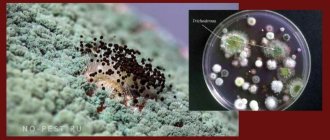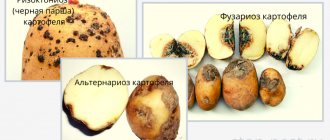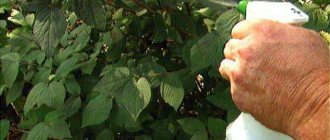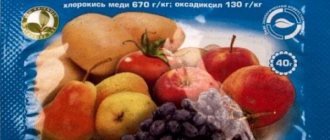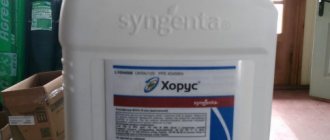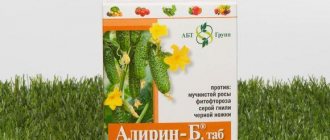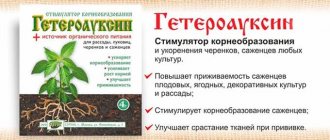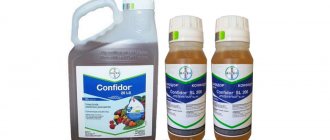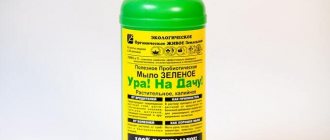Toxicity of Strobi fungicide
As a result of tests for residual amounts of Strobi carried out on cereals, seeds and grapes, good results were obtained.
Residues in the grain were beyond detection limits. After the waiting period, the apples contained virtually no Strobi residues. In soil, the drug decomposes very quickly with the formation of only one quantitatively significant metabolite, which is a biologically passive acid. In turn, the acid decomposes in the soil. Penetration into the deep layers of the soil does not occur, therefore, there is no danger of polluting it and water bodies. Strobi that gets into water also decomposes to acid. Toxicity for warm-blooded animals is very low. The drug is low-toxic and not dangerous. Processing is best done in the morning or evening hours.
The fungicide is toxic to humans upon direct contact with it, so it is necessary to wear protective equipment before work: goggles, protective clothing, gloves. You need to work with the drug carefully to avoid getting it on the body.
Hazard class: – III (moderately hazardous compound).
What to do in case of drug poisoning:
- remove dirty clothes and shoes;
- Wash your skin well with clean water and soap if the drug comes into contact with it;
- if the drug gets into your eyes: quickly and carefully rinse your eyes with open eyelids with clean water;
- rinse your mouth, drink as much liquid as possible - water;
- call a doctor;
- instructions for the doctor: treatment according to symptoms (maintenance of vital functions);
- a specific antidote is not known.
Strobi fungicide can be purchased from representatives of the official manufacturer BASF, as well as through retail chains. The price of Strobi fungicide depends on packaging and ranges from $120-150. for 1 l (kg).
Safety precautions during processing
As a result of the studies, the hazard class of the drug was identified as moderately dangerous (3).
Its toxicity is very low in relation to mammals and birds. Provided the specified dosages are observed, the drug does not harm bees. However, it must be used very carefully near ponds and rivers, no closer than 2 km.
For humans, the fungicide is dangerous only through direct contact.
When working with any drug of similar action, including Strobi, you should definitely follow all precautions,
using protective clothing: gloves, goggles. If the product gets on the mucous membrane, rinse immediately with clean water.
Photo of protective clothing for working with the drug
Features of application
Strobi, as stated above, causes resistance in fungal pathogens. But this is not the only reason that this drug is used exclusively in alternation with compatible fungicides of a different chemical nature, see below. The mycelium of parasitic fungi does not completely kill Strobi (see above). This drug completely decomposes quite quickly in air and light. At the end of its protective effect, the surviving hyphae of pathogens begin to grow again and can achieve sporulation. To prevent this, 3-7 days after treatment with Strobi, the plants are treated with a strong fungicide in minimal doses - it will kill young seedlings of pathogens, and the old ones will die off without producing growth and spores.
The second indispensable condition for the successful use of Strobi is its treatment of the soil around woody and woody perennials, as well as their trunks and trunks after harvesting. It will not harm beneficial mushrooms: they had already produced persistent spores, and the mycelium of perennials falls asleep for the winter. But zoospores of pathogens are just waking up in order to have time to invade the host plant before the cold weather. This is where Strobi will overtake them.
The third condition is crop rotation. Spores of pathogenic fungi of cultivated annuals overwinter in the soil, and no poison kills them. Since Strobe's ability to induce resistance in pathogens is high, and eradicating a resistant population is very difficult, the only way out is to rotate crops from systematically distant groups, see below. Harmful fungi, even of one species, are genetically plastic and quickly adapt to the most accessible plants. The spores of last year's pathogen, not finding a suitable host, simply will not germinate, and the resistant population will die out before it has time to emerge.
Note: a typical 3-fold treatment of Strobi per season (see below) is enough to last. year, the effect of the drug on the same affected object fell by 50-75%
Strobe Compatibility
The best results from Strobi are obtained when used in combination with other pesticides; time-separated treatment produces less effect. In tank mixtures, Strobi is compatible with the fungicides Delan, Cumulus and Poliram. If the appearance of a fungal disease is provoked by an attack by sucking and gnawing pests, Strobi can be combined with insecticides BI-58 and Fastak. The compatibility of the drug with these 5 drugs has been tested by the developer and confirmed by independent studies.
Interaction of Strobi with other drugs
Complex action fungicide “Strobi” can be combined with other plant protection products. This enhances the effect on pathogens that cause very serious diseases. As mentioned above, it can be used as a medicinal drug and to prevent the development of diseases.
It is permissible to combine the complex action fungicide “Strobi” with other means.
It can be alternated with the following protective agents:
- "Delan";
- "Topaz";
- "Quadris";
- "Fastak";
- "Polyram";
- "Horus."
And other means that are similar in action. This is necessary so that harmful mycelium cannot adapt to kresomsim-methyl, which is in Strobi.
Description of the fungicide
Strobes can be used to protect:
- fruit trees;
- vineyards;
- ornamental and berry bushes;
- vegetable crops;
- different types of flowers.
The effectiveness of the drug is due to the ability of strobilurins to interact with the surface layer of leaves and other parts of the plant and penetrate their internal tissues
Strobi fungicide not only suppresses the action of fungal pathogens, but also prevents the formation of secondary spores, which is very important for diseases such as scab
Fungicides based on strobilurins do not accumulate in soil and water bodies, as they are quickly destroyed. For example, when determining the residual amounts of Strobi in apples, its content turned out to be very small, and it was not detected at all in cereals. Strobi is low toxic to living organisms, which is its main advantage and, at the same time, a disadvantage. Fungi quickly mutate and become resistant to the drug. Resistance to the drug has been noted, for example:
- in powdery mildew of cereals and cucumber;
- gray rot in greenhouses on vegetables.
The greatest activity of the working solution appears immediately after preparation, which should be taken into account when using it. The amount of substance used depends on:
- depending on the type of crop being processed;
- approximate area to be sprayed.
Important! When using the drug Strobi, you must strictly follow the instructions.
Description
The chemical composition was found by specialists from Germany. Locally, the systemic substance contains several functions simultaneously. The active component affects pathogens and mycelium of microorganisms. Works on all manifesting forms of emerging infection. Used to prevent existing fungal infections and as a preventative measure.
Scientists - biologists, conducting endless experiments and experiments, discovered a useful fungus on the cones of pine trees, containing fungicidal properties. The active components block developing infectious lesions, prevent the possible spread and development of fungal spores.
The chemical is offered to the consumer in granular form. The granules quickly dissolve in water and therefore the solution is prepared just before use, strictly following the instructions for use attached to Strobi. The drug shows the best results immediately after spraying and, in order to achieve good results, the medicinal liquid is consumed within the period of time established by the standards.
Cultivated plants such as grapes, fruit bushes and trees, cucumbers, tomatoes, peppers, carrots, flower plantings of all types and garden roses are treated with Strobi. The treatment is carried out in good weather without wind or precipitation, in the morning or evening. The principle of operation of the product is as follows:
- with great effectiveness suppresses spores of harmful fungi that manifest themselves on the surface of leaf blades and fruits;
- if the leaf mass is already affected by infection, it has a healing – eradicating effect, suppresses sporulation and growth of the fungal mycelium;
- prevents recurrent outbreaks of infection, as it has the ability to quickly reduce and minimize the process of spore germination;
- has a protective effect at the first signs of infection;
Description and benefits of the drug
The new generation drug, Strobi, has a wide range of effects on pathogens of fungal plant diseases. The drug actively acts on fungi located on the leaves, stopping the growth of mycelium (mycelium) and sporulation.
Thanks to this quality, the drug helps fight diseases that arise as a result of spore germination. Fungicide Strobi belongs to the type of strobilurins: these are substances that inhibit cellular respiration by affecting enzymes specific to the fungal flora.
Acting in very small quantities on fungi, they are practically harmless to other organisms. This is the main advantage and main disadvantage of strobilurins, since fungi have the ability to mutate and become invulnerable to the entire class of drugs at once. Therefore, when using this drug, to achieve the best effect, follow the recommendations described in the instructions.
The advantages of the drug Strobi are:
- Uniform distribution of the product over the sheet surface.
- Impact on the entire sheet even when processing one side of it, due to penetration inside.
- Strong resistance to rain: light and heavy rainfalls do not wash off the product.
- Safety for bees.
- Resistant to temperature changes.
- Wide range of applications.
- Possibility of use during flowering plants.
- Low level of toxicity for animals.
The drug Strobi can be used against such plant diseases as:
- White spot
- Brown spot
- Ring spot
- Dry spotting
- Black spot
- Late blight
- Phomopsis sunflower
- Powdery growth
- Mildew
- Leaf spot
- Black
- tinder
- Alternasium rot
- Bitter rot
- Gray rot
- Scab
- Rubella
- Rust
- White rust
- Mildew
- Pale ascochidosis of peas
- Pea pod spotting
- Late photoblight (brown rot of fruits)
- Stem rot
- Anthracnose
- Stemphylliosis
- Gray mold
The results of studies on the residual amount of the drug in fruits showed that Strobi was not found in grain crops; in apples the content of the drug was very insignificant. When the drug gets into the ground, it quickly decomposes. The fungicide does not penetrate deeply into the soil; therefore, water bodies are not polluted.
The drug retains its protective properties after treatment:
- With an average infection – 10-14 days
- In case of severe infection – 7-10 days.
The effect of the fungicide Strobi manifests itself depending on the type and degree of the disease: from 2 hours to 2 days.
Period of protective action
The duration of action of the fungicide depends on the degree of development of the plant disease:
- If the infestation is not too advanced, it is enough to treat the plant only once.
- If pathological processes have too much impact on the health of the plants, then the product should be used at least 2 times.
- The period of protective action of "Strobi" in cases with an average degree of infection lasts 10-14 days from the moment of use.
- For severe stages of damage – 7-10 days.
Begins to act after 2 hours after application.
Important! You can strictly follow these recommendations, but it is much better to carefully read the instructions for the drug “Strobi” fungicide. The instructions for use for grapes differ, for example, from the rules for use for flower or vegetable crops.
The duration of action of the fungicide depends on the degree of development of the plant disease.
Instructions for use
The drug is famous for its excellent compatibility with other types of insecticides, which allows you to easily combine it with them, treating the plant with several drugs at the same time, which is actually recommended if you use the correct processing technology.
Strobi fungicide is also perfectly compatible with fungicides of other names and areas of application, which makes them excellent components for preparing powerful tank mixtures for treating and protecting plants from almost all diseases, especially those of a bacterial and fungal nature.
Manufacturers recommend treating plants with the fungicide Strobi 3 times a year, since according to their statements, as well as numerous observations of users of the drug, it is with this frequency of treatment that the best preventive and health-improving effect is observed.
As for the use of the drug, as well as the calculation of its dosage, everything is individual and depends on the type of plant being treated.
Thus, recommendations regarding the treatment of the most common country and garden plants are presented in the following paragraphs, such as:
- Grape. Strobi is excellent for processing grapes, especially if the vine has been exposed to oidium and mildew. The drug is excellent for preventing grapes from fungal invasions, as it creates a protective film on the stem, leaf and fruit that does not allow spores to germinate and develop. The solution should be prepared at the rate of 1 gram of the drug per 7 liters of water;
- Tomatoes. Tomatoes are most susceptible to late blight, which can occur in cool, wet summer conditions and can completely destroy your crop. Dilute 2 grams of Strobi in a 12 liter bucket, and the resulting solution is enough to treat 100 bushes. Strobi works well solo, but when processing tomatoes, we strongly recommend mixing it with other products to achieve the best effect. Tomato processing should be carried out 2-3 times per season, at intervals of 14 days. If a tomato is infected with late blight, plant the tomatoes in a different location next year;
- Cucumbers. Cucumbers are most susceptible to infection with powdery mildew and downy mildew. Spraying Strobi is carried out exclusively during the active growth phase, and no more than 2 treatments are carried out per season. Cucumbers can be harvested 10-14 days after the last treatment with the drug. Preparation of Strobi solution involves diluting 7 grams of the drug in 12 liters of water. A similar situation and dosages are relevant for pepper, regardless of the variety, with the exception of the smallest varieties;
- Fruit trees. Fruit trees are susceptible to pear and apple scab, olive mold, bitter rot and sooty mold. To treat one tree, mix 2 grams of the drug in 12 liters of water. During the season, 2-3 treatments should be carried out, with breaks of 14 days for trees up to 2 meters, and 30 days for trees over 3 meters high;
- Flowers and indoor plants. Flowers and indoor plants can be damaged by fungus and mold due to waterlogging of the soil, or the introduction of parasitic fungal spores from the outdoor environment. Strobi solution should be prepared at the rate of 4 grams of the substance per 12 liters of water. The number of treatments is 2 approaches, with breaks of 10 days.
You should not use Strobi more than 3 times in one year, as this may lead to the adaptation of pathogenic organisms and reduce the harmful effects of the drug presented in the article on them.
Scope of application
Strobi fungicide can be used to treat seeds to disinfect them, to spray trees, bushes, grapes and garden plants both after infection with fungi and for prevention.
It has a wide spectrum of action, affecting pathogens of rot, scab, powdery mildew, Alternaria, leaf spot, late blight, downy mildew, sooty fungus, mildew and oidium on grapes.
Pros and cons of the drug
Of course, in this case, having listed all the qualities of the Strobi fungicide, one should more clearly separate its pros and cons. One of the advantages of the drug is that the gardener receives a sufficient amount of material at a very affordable and optimal price. Also, the product independently sprays evenly over the surface of the sheets, so re-treatment is usually not required. During precipitation and rainy weather, the drug is not washed off and does not lose its effectiveness, which also plays a very important role, since it does not need to be sprayed on the plant again. The plant is reliably protected from parasitic and fungal diseases and is suitable for many crops existing today. If we talk about the lack of a fungicide, then it is still worth emphasizing the fact that this is a chemical solution, a chemical compound. If you use it unreasonably, in unlimited quantities, it can lead to poisoning of the body. Especially if a person does not follow safety rules and does not use a sprayer, mask and gloves when spraying, then the substance spreads very quickly throughout the body through the mucous membrane.
Distinctive features and advantages of the fungicide
Strobi fungicide has a significant advantage over many similar systemic drugs. He has quite a lot of individual characteristics and differences:
- the drug is used even during flowering of plants;
- during treatment, the substance spreads evenly onto the surface of the foliage;
- if the product gets on only one side of the sheet, then after a while it covers the entire plate;
- Strobi is a third-class hazard fungicide, it is safe not only for humans, but also for animals, birds, beneficial insects, and bees;
- the medicinal chemical is used in any weather, it is not afraid of precipitation, is not washed off by rain and functions functionally even after application to wet foliage;
- the fungicide is not afraid of low temperatures and is successfully used when the air cools to a slight minus;
- after using the drug, the vegetation and fruits of the treated crops are covered with a protective film, under which the fungal spores soon die;
- the toxicity of the chemical is low;
- compatible with many insecticides and fungicides;
- even though Strobi is not a very cheap product, the effectiveness justifies the price;
Professional help from gardeners and gardeners Still have questions? Ask, don't hesitateAsk a question
Fungicide Strobi instructions for use
Strobi comes in the form of granules that quickly dissolve in water. The solution is prepared immediately before use according to the standards. Its greatest effectiveness is observed in the first two hours after preparation. In this regard, it is necessary to use the solution within this time.
Work should be carried out in dry weather, preferably in the morning or evening. In order for the plant to be completely treated with the solution, it is recommended to spray on a windless day.
Strobi fungicide is classified in the third, moderately dangerous class. It does not pose a danger to humans, animals, or birds. Strobe is practically harmless to bees, but before you start treating plants, it is still necessary to notify local beekeepers in advance. The practice of using this Strobi fungicide shows that a border protection zone of a maximum of 2 km is sufficient for bees.
The number of fungicide treatments depends on the type of plant. To prevent flowers from powdery mildew and rust, spraying should be carried out during their growing season 2-3 times every 10 days. The exception is roses. They need to be treated twice a month, starting on July 1 and before sheltering for the winter. In this case, it is necessary to treat not only the foliage, but also the soil around the roses
Please note that when treating fungal diseases in flowers, the fungicide is only effective in combination with other drugs
Vegetable crops are treated with Strobi twice during their growing season. The solution destroys diseases such as late blight and powdery mildew in tomatoes, downy mildew in cucumbers, and brown spot, which affects carrots and peppers. It is recommended to alternate the Strobi fungicide solution with other drugs. The waiting time, which is the period from the date of the last treatment until the harvest, differs for vegetables growing in open ground and greenhouses. For cucumbers and tomatoes growing in open ground, this period is 10 days; for tomatoes growing in greenhouses - 5 days, and for cucumbers - 2 days.
Fruit trees are processed three times during the growing season with an interval of 14 days. The last spraying must be carried out 35 days before the start of fruit harvesting. The solution is prepared based on the growth of the tree. For 1 meter of plant, 2 g of the drug per 10 liters of water is enough. Alternating the drug with other similar ones is mandatory.
Fungicide Strobi effectively affects the destruction of scab, powdery mildew, root canker and other diseases of grapes. Treatment must be carried out throughout the entire growing season. In this case, you should spray not only the leaves, vines and fruits, but also the soil in the root zone. The solution is applied twice within 7-10 days. Treatment must be stopped one month before harvest.
Release form of the drug Strobi
An effective preparation for treating plants, Strobi is a water-soluble granule, which is produced in bags weighing 2 g. Less commonly, you can find packages of 100 g on sale. According to the instructions, its use is most effective in the first two hours after preparing the solution.
What is the purpose of the drug
The appearance on sale of a fungicide that is effective against severely damaged plants by pathogenic fungi and at the same time safe enough for use on ripening fruits caused a sensation at the time. Strobi has even been dubbed a new generation drug. True, the sensation did not completely materialize: the drug turned out to be quite difficult to use (see below) and causes resistance in the affected objects. However, the trail remains undeniable. its advantages:
- The use of Strobi makes it possible to reduce the dose of toxic pesticides per unit of land area by at least 1.5-2 times.
- The final treatment of the season with this preparation can be carried out at almost any stage of crop ripening, which sharply reduces its losses during storage.
- A wide spectrum of action does not require accurate diagnosis of the disease and, accordingly, deep knowledge of agricultural technology by the user.
- The drug is most effective when applied to wet foliage. In the temperature range of +(1-4) degrees Celsius, Strobe activity increases from initial to almost complete. That is, Strobi is most effective as a spring preventive fungicide for a garden or vineyard. Spring prevention with a safe product allows you to further reduce the consumption of toxic chemicals.
As a result, firstly, the drug Strobi has proven itself to be excellent in conditions of closely spaced plantings in small areas: fruits from adjacent plots of land to the treated area can be consumed without fear. Therefore, Strobi is already very popular in dachas and garden plots, see for example. video:
Video: Strobes for plant and fruit protection
Secondly, when the above-ground fruits of plants are intended for long-term storage. Tubers and tuber crops are much easier to protect from the accumulation of pesticide residues than pome fruits, stone fruits and berries. Therefore, Strobi was fully appreciated by gardeners, see the story:
Video: Strobes for spring garden processing
Fungicide Strobi stops the development of the mycelium of imperfect fungi and the sporulation phase; This drug only stops the growth of mycelial filaments. In fungi whose life cycle includes a stage of dispersal zoospores, Strobi deprives the latter of their motility. Since the life cycles of pathogenic and beneficial soil lower fungi are very different, Strobi has virtually no effect on soil-forming fungi when used correctly. Action Strobi preim. contact: the dried working solution forms a dense film on the plants that is not washed off by rain; The drug penetrates into plant tissues weakly, only while the working solution dries.
Advantages and disadvantages
The drug Strobi is very popular due to its benefits.
Strobi preparation for spring garden treatment - video
Among the main advantages:
- the possibility of safe use of Strobi during the flowering period;
- rapid penetration and uniform distribution within plant tissues;
- long-lasting effect that lasts for one to two weeks;
- economical use;
- quickly washed out of the soil;
- applicable at any stage of plant infection by fungus;
- Strobi is safe for the environment, including humans, animals, plants, pollinating insects;
- the protective effect continues even with high humidity and precipitation.
The drug has several disadvantages. Among them, the constant need to accurately calculate the product in the proportions required for each specific plant. Compliance with consumption standards will allow you to obtain the desired effect.
Composition and benefits of the drug
The active ingredient of Strobi is kresoxim-methyl, a substance that has high bactericidal activity. Preparations based on this chemical have therapeutic and protective properties. Plants and trees with obvious signs of damage should be treated.
The new generation drug Strobi effectively fights diseases of vegetable and fruit crops. The fungicide suppresses the development of pathogenic microorganisms. The most important advantage of Strobi is that it is almost harmless to humans and animals. It has many other advantages:
- the action is effective for most garden and vegetable crops;
- prevents further manifestation of infection;
- does not lose its properties after precipitation or temperature changes;
- quickly penetrates inside the sheet, there is no need to treat the lower part.
The use of Strobi fungicide provides protection against powdery mildew, late blight, scab and other dangerous but common diseases.
Precautionary measures
The solution is prepared in a separate container. And although the drug is not dangerous for humans and animals, it is worth adhering to safety measures:
- When carrying out all types of work with fungicide, wear a protective suit and ensure protection of mucous membranes;
- wear thick rubber gloves;
- After all activities, wash your hands thoroughly under running water.
Rinse containers that have been used well. Keep away from food and other substances.
Recommendations for preparing and storing working solution
To achieve maximum effect, the concentrate is diluted correctly.
Features of preparing the working solution
To prepare a solution of the drug, you should adhere to the following rules:
- 1 sachet is poured into 1 liter of liquid. Stir until a homogeneous composition is obtained without crystals and granules.
- Half of the required water is poured into the irrigation container and the concentrate is added. Stir continuously.
- Then the composition is added to the specified norm.
To treat tomatoes in open areas, prepare a solution in the following combination:
- 2 g granules;
- 10 liters of water.
To process greenhouse tomatoes, take:
- 2 g granules;
- 7 liters of liquid.
What are the features for processing tomatoes under different growing conditions:
- In open garden beds. To irrigate 100 adult plants, 10 liters of the prepared solution will be required. For 100 m2 you need to use 4 liters.
- In greenhouses, greenhouses, biovegetarians. For 1 m2 of planting, 100 ml of solution is needed.
Period of use and storage
The shelf life of the drug in a sealed package is 5 years from the date of release.
The working solution is prepared immediately before irrigation; do not store longer than 2-3 hours.
Storage conditions and periods
According to the instructions (EC Regulation No. 1907/2006), it is necessary to strictly follow the rules for storing and handling Strobi fungicide:
Strobi works well with other fungicides
- storage near food products, aromatic substances, and pet food is unacceptable;
- provide protection from wetness, humidity, and heat;
- exposure to heating devices, hot air flows and direct sunlight is strictly prohibited;
- Store in a work area with adequate ventilation and exhaust;
- observe fire safety rules - the formation and accumulation of fine dust is unacceptable to avoid explosion and self-ignition;
- release date and shelf life are indicated on the packaging - up to 4-5 years;
- storage temperature – no more than 400C.
How to use the drug correctly, instructions for use
“Strobi” is a broad-spectrum fungicide, the instructions for use of which are very easy to understand, and reviews from gardeners and gardeners, in most cases, are quite flattering.
How to use "Strobe" for flowers?
When growing flowers, experienced gardeners spray them with fungicides to combat powdery mildew and leaf rust. In this case, the drug “Strobi” is used to prepare a solution, the instructions for use are as follows: dissolve 5 grams of fungicide in a bucket of water. The resulting solution remains most effective for two hours after preparation, so it must be used rationally during this time. During the growing season, it is better to treat flowers using a sprayer, spraying three times a month.
Important! When growing roses, you need to spray not only the leaves, but also the soil near the bushes.
Using the drug in the garden
The drug "Strobi" is perhaps the safest fungicide for garden plants, and for grapes in particular. It effectively prevents the proliferation of fungal diseases that appear on the fruits and leaves of plants. Even after infection with a fungus, the Strobi fungicide effectively treats the infected object, and then eliminates the disease by suppressing sporulation and mycelial growth. Due to the fact that new spores no longer germinate, large-scale outbreaks of the disease can be prevented. If the plant was infected for the first time, then “Strobe” also has a protective effect against future attacks of viruses.
This drug helps cope with black spot, powdery mildew, basal shoot cancer, scab and rust. The drug "Strobi" can also be used for grapes for preventive purposes, despite the fact that the instructions for use indicate the possibility of spraying only during the growing season. The treatment affects leaves, fruits, trunk and soil in the root zone. Grapes should be sprayed twice every 10 days. The last treatment is carried out a month before harvest.
Other fruit trees should be treated with Strobi fungicide during the growing season (up to three times throughout the season). Treatment is carried out at two-week intervals. “Strobi” should be alternated with other fungicidal preparations: “Skor”, “Cumulus DF”, “Bordeaux mixture”. The last treatment of fruit trees is carried out no earlier than 35 days before harvest.
Did you know? The Paris Japonica plant has the longest genetic code known on the planet. The gene consists of 149,000,000,000 nucleotide pairs! This is 50 times larger than the human genome! If you line up the entire DNA chain in a straight line, the thread will be 90 meters long!
Instructions for use of "Strobi" for vegetable crops
Vegetable crops, by analogy with fruit trees, are processed during the growing season. The best conditions for the procedure are dry, windless weather.
When using Strobi as a fungicide for vegetable crops, remember that the instructions, in particular for tomatoes, peppers, carrots and other crops, are generally the same. This drug effectively copes with late blight and powdery mildew of tomatoes and carrots, downy mildew of cucumbers and other diseases.
Fruit-bearing vegetable plants are treated by spraying, but it is better to use “Strobi” in combination with “Quadris” or “Abiga-Pik”. The treatment cycle is as follows: first, spraying is carried out with the “Strobi” composition, then with another fungicide, and then again with “Strobi”. Next year, it is recommended to plant others instead of the treated vegetable plants.
Vegetables should be sprayed twice during the growing season, and the waiting time from the last treatment until harvest depends on the specific crop:
- for tomatoes and cucumbers growing in open ground - this is 10 days.
- for tomatoes in closed ground - 5 days.
- for cucumbers in closed ground - 2 days.
Important! The Strobi fungicide is very toxic, so when working with it you must follow the safety precautions described in the instructions.
Be sure to wear gloves, safety glasses and a robe, which then needs to be changed and washed well
Preparation of solution and processing rules
The treatment season begins with the spring preparation of plants (planting time). Duration: from planting seedlings to harvesting. But with one condition: no later than a month before harvesting the fruits.
The ratios for diluting Strobi must be observed: 5 g of the substance per 10 liters of water for treating plants in open ground and 10 g per bucket for crops in closed ground. The shelf life of the prepared mixture is up to 48 hours.
It is advisable to use immediately after preparation and not keep for more than a day. Already on the second day, the effectiveness of the fungicide decreases.
Vegetables
It will be easier to use Strobi for vegetables if you remember the application doses and purpose of the substance. The effect is achieved by adding 2 g per bucket for diseases (powdery mildew, late blight, brown spot and downy mildew). Convenient time for spraying: growing season.
Tomatoes and cucumbers, carrots or peppers, but the dosage for dilution is the same. Number of times – up to two. Next year, the landing site should be changed.
Application procedure
Strobes cannot be stored in opened packaging. The working solution of the drug is prepared immediately before use and must be consumed within 2-3 hours. The preparation method is usual: fill the tank halfway with water, make a mother suspension in a liter or half a liter of water, pour it into the tank while stirring. The tank is topped up to normal, closed, shaken vigorously several times and get to work. Every hour (if the work has been delayed to the limit), the sprayer tank also needs to be shaken.
Instructions for treating horticultural crops with Strobi fungicide are given in the table:
In all regulations, it is necessary to alternate Strobi with compatible fungicides that do not contain strobilurins.
The minimum acceptable interval between treatments is 10 days.
When alternating crops, it is not advisable to plant plants from the same systematic groups next year (nightshade after nightshade, pumpkin after cucumber).
For perennials, the first treatment is in spring, along the green cone (the beginning of the buds unfolding). Annuals are treated for the first time when the seedlings develop 2-3 leaves after planting in place. “Ground” annuals (sown immediately in a bed/container in a greenhouse) are treated for the first time when 3-4 true leaves are unfurled. Floral - the first time along the green cone and when the buds open. If roses suffer greatly from these diseases, the number of treatments can be increased to 3-4 per season, but then Strobi cannot be used in the same flower garden for the next year.
Note: according to empirical data from amateurs, Strobi is also effective against fly beetles and prevents bitter, moniliosis, penicillium and mold rot of fruits during storage.
In the vastness of large-scale agricultural technology, Strobi has so far more or less taken root only in medium-sized gardening. In large areas, the high and rapid resistance of pathogens to the drug is a huge disadvantage, and the services of specialists in accurately determining safe doses of pesticides and the content of their metabolites in products are not detrimental to the profitability of the farm. But for neat and attentive, even if not yet very experienced, owners, Strobi is truly a new generation fungicide
Beginning private owners or weekend summer residents should pay the most serious attention to this drug.
Area of effect of the fungicide
The drug Strobi for planting grapes is used in cases of infection:
- black spotting, as well as white and brown, ring spotting;
- white and gray rot of stems;
- mildew;
- scab;
- white rust, leaf spot;
- anthracose;
- oidium, etc.
The fungicide demonstrates its best qualities in preventive measures. With his help and participation, it is easy to prevent the appearance of diseases or pests.
Dosage
To use the drug Strobi as a medicinal or prophylactic substance, you need to know the dosage for application. The working solution is made to quadrature the area. The calculation of dosages depends not only on what the purpose of processing the plants is. Please note:
- type of culture;
- presence of the disease and its name;
- how the work will be carried out.
For fruit and berry crops (trees, shrubs), in the presence of all types of diseases, treatments can be done a maximum of 3 times a season at 0.026 g per square meter. For prevention, reduce the dilution gates - 0.014 g per square meter. m. Alternation with fertilizers of other classes is allowed.
Vegetable and ornamental crops are treated with a diluted composition with a Strobi dose of 0.02 or 0.03 g per square meter. m. Fungal infections on flowers and decorative ones are eliminated with a working mixture at the rate of 0.04 g. Number of treatments: no more than 2 times permissible.
Reviews from gardeners
Arkady, Saratov: “I use the drug to treat plants in my own garden plot. Strobi can be counted among the universal and highly effective means for combating the main pathogens of fungal diseases and scab on grapes and nightshades. Neighbors are also used for ornamental plants (indoor and garden flowers, shrubs).”
Valeria Ivanovna: “It is important not to miss the time of treatment with the drug. I process roses in the autumn during preparatory work. I especially like the fact that Strobi is absolutely non-toxic for people and insects, and also that it can be used in stationary greenhouses, which is important for me in the spring.”
Correct and timely use of Strobi on a personal plot will help avoid mass plant death. The low price of the drug and high efficiency, noted by professionals and amateurs, allows you to get a decent reward for your work in the form of a rich harvest without any special expenses.
Composition and mechanism of action of the drug Strobi
Biological, created on the basis of natural toxins, Strobi fungicide is a universal remedy for combating fungal diseases of cultivated crops. According to the instructions, it is characterized as a highly effective product, the effects of which are detrimental to all types of pathogens. Its use is permissible at all stages of plant infection. The safety of using Strobi is due to its low toxicity. On the one hand, this is an undeniable advantage, on the other hand, it is a disadvantage. For example, when using Strobi for apples and tomatoes, no residual substances from the fungicide were found in the fruits. However, it is the low toxicity that forces pathogenic microorganisms to mutate, which increases their immunity to the protective agent.
The action of the fungicide is strobilurin, that is, a substance that inhibits the cellular respiration of fungal pathogens. Even in small quantities, strobilurins effectively fight fungus without harming other living beings - plants, animals or humans. The local-systemic action of Strobi is aimed at protecting and treating cultivated plantings and suppressing the development of fungal growths on leaves and fruits. The active substance in the composition is kresoxim-methyl, which has a detrimental effect on most pathogenic microorganisms. A fungicide can simultaneously replace several drugs of similar action.
Strobi: characteristics of the drug
It belongs to modern means and has a wide range of effects. Strobi stops the development and growth of fungus on the leaves and the formation of new spores. The drug is characterized by a high degree of blocking their germination and further development of the disease.
Photo of the drug Strobi
The drug Strobi is from the class of strobilurins. The main active ingredient is kresoxim-methyl.
This and related substances have an inhibitory effect on the respiratory ability of cells through their effect on the enzymes possessed by the fungal flora.
They are able to eliminate even a small amount of fungus. The composition of Strobi is completely safe for humans and plants.
On the one hand, this is a positive point, on the other hand, fungi adapt quite quickly and are able to change quickly, which reduces the effect of the drug.
To get the greatest effect, you need to dilute Strobi in the exact dosage and use it in accordance with the instructions.
Brief overview of the drug Strobi - video
The product is available in granular form.
The granules themselves dissolve perfectly in water. The drug Strobi penetrates the leaf plate better than other similar products and is evenly distributed both inside and outside. You can treat only one side of the sheet and the substance will gradually penetrate into the other part.
You can safely treat fruit trees and grain crops with Strobi fungicide. Research has proven that the substance does not accumulate in fruits at all and does not have any harmful effects.
So, in apples the concentration is very small. Once in the soil, Strobi quickly decomposes and does not penetrate very deeply, which is also environmentally friendly, since it does not lead to pollution of water bodies.
